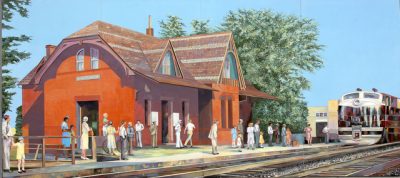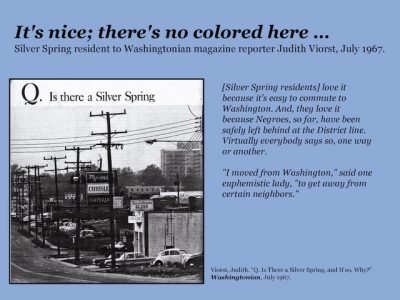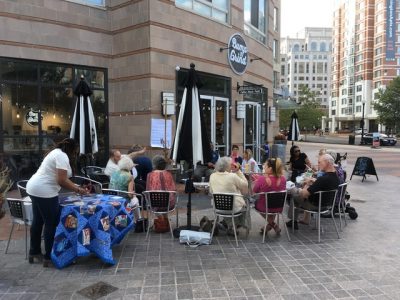My community’s history is racist. How can I correct it?
27 November 2017 – David Rotenstein

Silver Spring “Memory Wall” mural depicting the B&O Railroad station, c. 1940s. Photo credit: David Rotenstein.
This is an exciting and anxiety-producing moment in the United States. It is a time when professional historians are stepping outside their classrooms and consulting practices to push for the removal of Confederate statues and for greater public dialogue about the roles that white supremacy played in the past and how it persists in our communities. There is no instruction manual for what to do if you discover that the community in which you live inadvertently celebrates white supremacy and omits or minimizes African American history and civil rights history. What can public historians do if they discover that previous state-sponsored historic preservation and placemaking efforts have erased the black experience?
I am a public historian who has been collaborating with local nonprofits in my community of Silver Spring, Maryland to write that manual and reverse the community’s erasure of African American history and civil rights history. When I moved back to Silver Spring in 2014 after living for three years in Georgia, I began revisiting some of the history books, historical markers, and media coverage that had informed my first stint in the suburb from 2000 to 2011. In that time, I had worked as a historic preservation consultant, chaired the Montgomery County Historic Preservation Commission, and taught cultural anthropology at Montgomery College.

Slide from a recent T3 fundraising event held in a Silver Spring home. Image credit: David Rotenstein.
I had not thought to interrogate how history and historic preservation are produced in Silver Spring until I took on the task of writing a book about gentrification and the erasure of black history and black bodies in Decatur, Georgia, an Atlanta suburb. Upon my return to Silver Spring, I found a 2002 Montgomery County historic preservation survey of Silver Spring’s central business district in which the words “African American” and “black” didn’t appear. In addition, I found websites and books produced by the Silver Spring Historical Society that also omitted African Americans along with any information about Silver Spring being a sundown suburb: a place where African Americans could not buy or rent homes or apartments in most of a ten-square-mile area between 1900 and the 1960s. Silver Spring was a place so entrenched in Jim Crow that in 1967, Washingtonian magazine quoted a resident praising the community’s desirable qualities: “It’s nice; there’s no colored here.”
In the historical society’s books and other media, I did find uncritical adulation of Silver Spring’s nineteenth-century founders, the slaveholding Blair family, and the twentieth-century suburb’s mastermind, Democratic political boss and unrepentant segregationist E. Brooke Lee. The same year that Washingtonian exposed Silver Spring’s entrenched racism, Lee was railing against open housing laws that he described as “anti-white” and as threats to the “continued existence of the great suburban Montgomery County.”
As I was re-reading Silver Spring’s histories and exploring its commemorations of Lee, Blair, and all the white community builders who wouldn’t serve African Americans in their restaurants, who excluded blacks from public spaces like Silver Spring’s much-beloved armory, and who established more than 50 residential subdivisions where African Americans couldn’t live, I began asking people where I could find sites associated with black history in downtown Silver Spring. There were none that the Montgomery County Historic Preservation Office could name. Folks who I asked in stores, at the farmer’s market, and elsewhere pointed me to Lyttonsville or Sandy Spring, neither of which is in Silver Spring’s central business district.

T3’S “Invisible Montgomery” group met in August at a local coffee shop. Photo credit: David Rotenstein.
Drawing on research by Bruce Johansen, a Minnesota native who wrote a 2005 doctoral dissertation on historic preservation and community in Silver Spring, as well as interviews with longtime African American residents of historically-black Lyttonsville, I developed a Silver Spring Black History tour through the downtown area. There are 20 stops in the two-and-a-half-hour walking tour. Stops in the tour include an office building where about 200 African American Department of Labor office workers were transferred in 1961. Shortly thereafter, one of the employees tried to eat lunch in an area restaurant and was denied service; the interaction began nearly four years of litigation and county complaints.
Besides the tours and the talks I have been giving in local churches and synagogues, I also began working with IMPACT Silver Spring, a local network-building nonprofit, in its racial equity initiative. In May, I participated in a panel discussion on structural racism at the nonprofit’s annual IMPACT Now program in the Silver Spring Civic Building. That collaboration led to planning an event in Silver Spring’s Acorn Park, the site of the community’s namesake and another stop in the Silver Spring Black History Tour. In the 1990s, Montgomery County leaders commissioned a District artist to paint a “memory wall” with panels depicting Silver Spring at five pivotal points in its history (see image above). One of the murals depicts African Americans waiting for a train in 1941 at Silver Spring’s B&O Railroad station. Because of Jim Crow segregation, the scene depicted could never have occurred. The mural creates a false sense of history—an erasure of segregationist history—by inserting black bodies into a space and time where they would not have been allowed.
The surface on which the murals appear is a former department store exterior wall next to Acorn Park for which the Montgomery County Department of Parks has a perpetual easement. In early 2017, the Montgomery County Parks Department began soliciting public input for planned renovations to the park. IMPACT, Showing Up for Racial Justice (SURJ) Montgomery County, and I organized the direct action event in the park in June where about 40 participants learned about Silver Spring’s history as a sundown suburb and the inaccurate scene depicted in the murals. Participants were asked to sign petitions to Montgomery County leaders asking for a more inclusive and accurate history to be presented in the park.
We followed-up the Acorn Park event with a series of monthly meetings sponsored by IMPACT as part of its T3 (Truth, Trust, Transformation) networking initiative. These meetings have taken on the tasks of trying to engage the county to make spaces like Acorn Park more inclusive, organizing a campaign to get a Silver Spring street renamed for local civil rights pioneer Roscoe Nix (the Labor Department employee who filed the first complaint under Montgomery County’s 1962 Open Accommodations law), and exploring ways to better educate Montgomery County residents about our county’s complete history, warts and all.
Meanwhile, in Decatur, the community that raised my awareness of how history and public policy intersect, activism has taken on a definite historical character. Decatur‘s whitewashed history seems to have become lost among more timely and politically palatable issues. There, historians are on the front lines of social justice activism working to remove a Confederate memorial and advocating for immigrant rights protection.
Collectively, historians have been vigorously engaged in responding to last year’s election. Current events are enabling public historians to push disciplinary, institutional, and personal boundaries in ways unanticipated before November 2016. I see this as a work in progress for both myself and the field of public history as a whole.
~ David Rotenstein is a consulting historian based in Silver Spring, Maryland. He researches and writes on historic preservation, industrial history, and gentrification.




I grew up in silver spring in the 30’s and 40’s. I loved it and still think about how wonderful it was. I am very interested in photos of the area from the train station to colesville rd